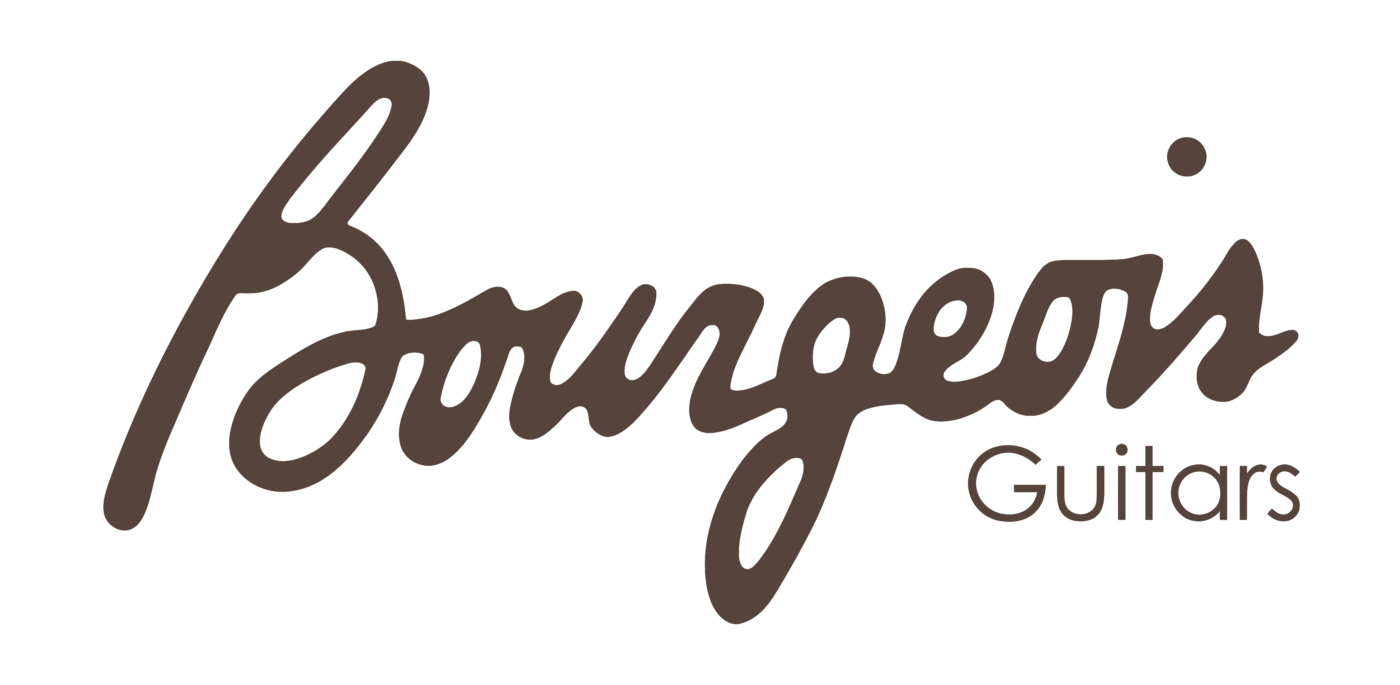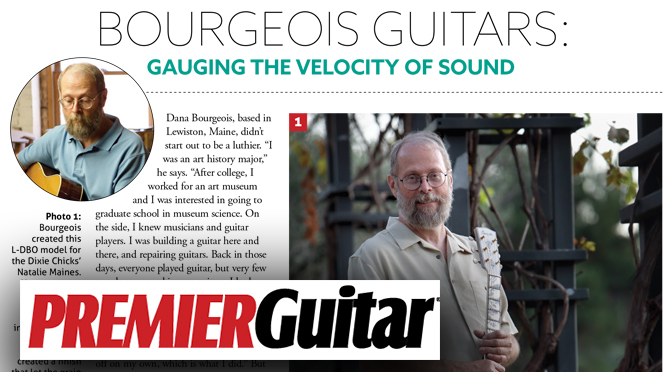Homepage News, Review & Articles
Bourgeois Guitars – Gauging the Velocity of Sound
As featured in Premier Guitar.
Download a PDF of the article here, or read the complete article from Premiere Guitar here.
PREMIER GUITAR JULY 2017
Dana Bourgeois, based in Lewiston, Maine, didn’t start out to be a luthier. “I was an art history major,” he says. “After college, I worked for an art museum and I was interested in going to graduate school in museum science. On the side, I knew musicians and guitar players. I was building a guitar here and there, and repairing guitars. Back in those days, everyone played guitar, but very few people were working on guitars. I had people bringing guitars to me, asking, ‘Can you fix this?’ One day, I had this epiphany that I liked people in the music world more than I liked people in the art world. I had enough business to quit my job and go off on my own, which is what I did.” But he was still years away from establishing his own company, Bourgeois Guitars.
He started working at the Music Emporium in Cambridge, Massachusetts (now located in Lexington, Massachusetts), where he befriended Eric Schoenberg, one of the store’s owners, and they eventually founded Schoenberg Guitars. “It was the very beginning of the renaissance of the OM guitars,” Bourgeois says. “The Music Emporium was ordering OMs through Martin’s custom shop as custom instruments. Eric and I put out one of the first production OMs. Ours also featured a cutaway and we did that for a while. I would go down to Martin— they would build in batches of 20—and I would voice the tops down at Martin.” Doing repairs also gave him exposure to vintage instruments. “The exposure I had to vintage guitars through the Music Emporium was invaluable. At any time, I might have what today would be a million dollars’ worth of instruments in my shop.”
That exposure, plus years of experience, has made Bourgeois a master voicer. (Watch him voice a top on Vimeo, under the search term Dan Bourgeois Top Voicing Demonstration.) He voices every instrument his company, which he founded in 1992, sells. “My approach is to get as many different resonant frequencies as possible out of the guitar top and back,” he says. “My philosophy of building, regardless of the size of the guitar, is to get good balance and clarity: string-to-string and note-to-note balance. I want a strong fundamental and a strong series of overtones as opposed to a sketchy series of overtones. My approach to voicing is to build within a very narrow range of flexibility. The top is built for a narrow range of flexibility both across and along the grain. It starts out stiff and as you work your braces, you work down to the desired level of flexibility. There is no way that you’re going to get every note to be equally strong. It simply doesn’t happen that way. If you did, every guitar would sound like a synthesizer. They all have their own individual characteristics. The key is that every piece of wood is a little bit different. You have to work with what you’ve got and try to bring out the greatest variety.”
Bourgeois Guitars are known for their Aged Tone instruments. These guitars are built with torrefied wood, a special “aged” lacquer, and an animal protein glue made from fish bones and cartilage (as opposed to horse hooves or rabbit hide). “Torrefaction is cooking wood in an oxygen-free environment,” Bourgeois says. “The idea is to cook off the volatiles in the wood— sugars, oils, pitches, resins—that would normally oxidize over many decades. If you do it right, you increase the stiffness of the wood and lower its weight. You increase the stiffness-to-weight ratio, which is the formula for velocity of sound. That sort of broken-in guitar sound that everyone talks about in an older guitar is really about an immediate explosive response and the ability to generate higher overtones. When you play a note, you play the fundamental tone and the wood will generate higher overtones unless it is damped. The stuff that’s cooked off has a damping effect. Torrefaction is a way of making a guitar that breaks in a lot sooner.” A new finish has a damping effect as well. “Lacquer takes 25 years or so to fully cure. It’s kind of like concrete. It never stops curing. Together with our finish supplier, we helped develop a finish that has the hardness and density qualities of an older lacquer finish. If it’s applied thinly enough, it will not damp the sound of a new guitar.”
Bourgeois builds about 400 guitars a year. He has 17 employees, 12 of whom are in the shop—and that includes him. “I am the owner and CEO of a small company,” he says. “A lot of my peers don’t spend any time in the shop any more. I spend most of my time in the shop, and that’s the way I like it.”

